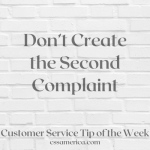A Toronto mayoral candidate is campaigning in such a manner as to try to appeal to small businesses and economic growth. One area of focus in his campaign is customer service.
It’s interesting to note how politicians are talking customer service. Why would they do that? Well, there are two key reasons. First is that government in general has (deservedly or not) a reputation for delivering poor customer service, not being responsive, not having the same attitudes that one should find in organizations competing for the customer.
Second, great customer service is something that their customers – the voters – find important. We can debate whether or not it’s the number one issue, but it IS important.
Think about this in terms of how it relates to your business. What is important to your customers? What is their hot button issue? In what aspects of your organization do customers perceive you negatively?
To ANSWER these questions, you have to ASK these questions of your customers.
Ask, listen, learn, prioritize, improve, and then campaign for your customers.
Interested in improving your company’s customer service? See more information at: http://www.cssamerica.com/
Check out our new customer service book at http://www.amigreatat.com/





















